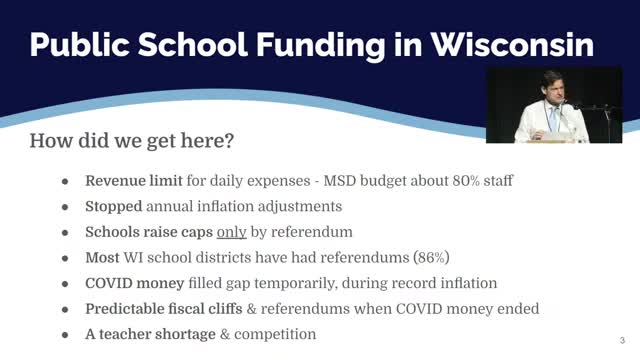School funding crisis looms as inflation outpaces support
July 28, 2024 | McFarland School District, School Districts, Wisconsin

This article was created by AI summarizing key points discussed. AI makes mistakes, so for full details and context, please refer to the video of the full meeting. Please report any errors so we can fix them. Report an error »

During a recent government meeting, discussions centered on the pressing issues surrounding school funding in Wisconsin, particularly within the McFarland School District. Melanie Roback, a parent and educator, highlighted significant discrepancies in state funding, asserting that it has not kept pace with inflation, which has led to a funding gap that many districts are struggling to address.
Roback explained that a 1993 state law limits how much property tax revenue can be allocated to schools, establishing a revenue limit based on a per-student funding model. In McFarland, the district receives approximately $12,000 per student, slightly above the state minimum of $11,000, due to a referendum passed in 2004. However, this funding model has not been adjusted for inflation in over a decade, creating a fiscal challenge as operational costs continue to rise.
The meeting underscored the reliance on operational referendums, which have become essential for districts to raise their funding caps. Roback noted that 86% of Wisconsin school districts have pursued such measures since the state halted annual inflation adjustments. The McFarland district, however, has not passed a referendum recently, resulting in a significant funding shortfall as federal COVID relief funds, which temporarily alleviated budget constraints, are now depleted.
Roback emphasized the urgency of addressing these funding issues, particularly in light of a growing teacher shortage exacerbated by below-average salaries in the district. With McFarland ranking among the lowest in per-pupil funding and teacher pay in Dane County, the district faces challenges in attracting and retaining qualified educators.
The meeting concluded with a call for community engagement and support for future referendums to ensure that the district can maintain its educational standards and staff levels. As the fiscal landscape continues to evolve, the need for a sustainable funding model remains a critical concern for the McFarland School District and its stakeholders.
Roback explained that a 1993 state law limits how much property tax revenue can be allocated to schools, establishing a revenue limit based on a per-student funding model. In McFarland, the district receives approximately $12,000 per student, slightly above the state minimum of $11,000, due to a referendum passed in 2004. However, this funding model has not been adjusted for inflation in over a decade, creating a fiscal challenge as operational costs continue to rise.
The meeting underscored the reliance on operational referendums, which have become essential for districts to raise their funding caps. Roback noted that 86% of Wisconsin school districts have pursued such measures since the state halted annual inflation adjustments. The McFarland district, however, has not passed a referendum recently, resulting in a significant funding shortfall as federal COVID relief funds, which temporarily alleviated budget constraints, are now depleted.
Roback emphasized the urgency of addressing these funding issues, particularly in light of a growing teacher shortage exacerbated by below-average salaries in the district. With McFarland ranking among the lowest in per-pupil funding and teacher pay in Dane County, the district faces challenges in attracting and retaining qualified educators.
The meeting concluded with a call for community engagement and support for future referendums to ensure that the district can maintain its educational standards and staff levels. As the fiscal landscape continues to evolve, the need for a sustainable funding model remains a critical concern for the McFarland School District and its stakeholders.
View full meeting
This article is based on a recent meeting—watch the full video and explore the complete transcript for deeper insights into the discussion.
View full meeting
